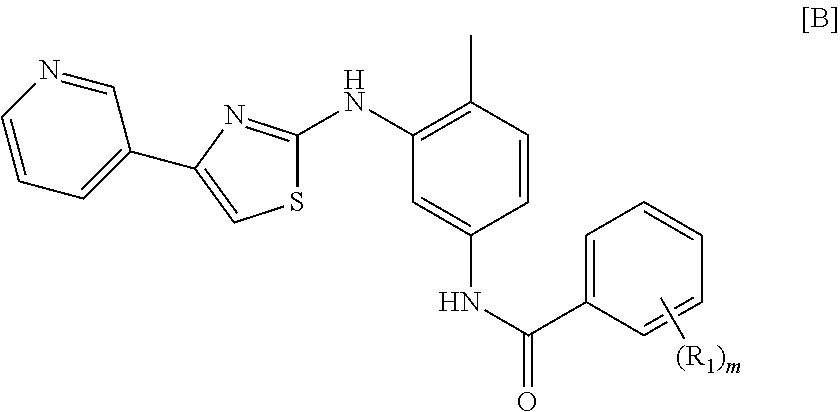Treatment of mastocytosis with masitinib
a technology of masitinib and mastocytosis, which is applied in the direction of organic active ingredients, pharmaceutical active ingredients, sulfur/selenium/tellurium active ingredients, etc., can solve the problems of uncontrolled hypersecretion of these mediators, deleterious to the body, and limited effect of the body
- Summary
- Abstract
- Description
- Claims
- Application Information
AI Technical Summary
Benefits of technology
Problems solved by technology
Method used
Image
Examples
example 1
Phase IIa, Open-Label, Randomized Study of Oral Masitinib in Patients with Systemic Indolent or Cutaneous Mastocytosis, with Mast Cell Mediator Release Associated Handicap and not Bearing Activating Point Mutations in the Phosphotransferase Domain of c-Kit Such as the Main Mutation Asp-816-Val (D816V)
Methods
Study Design
[0226]This was a phase 2a, multicentre, open-label trial over 12-weeks, with an extension phase possible for those patients experiencing improvement, to evaluate the dose response of masitinib in indolent forms of mastocytosis with handicap. Dose ranging was performed by randomly assigning patients (1:1 ratio) into initial treatment groups of 3 or 6 mg / kg / day. Masitinib, supplied as 100 and 200 mg tablets (AB Science, France), was administered orally in two daily intakes. Dose adjustments of 1.5 mg / kg / day were permitted, with the dosage being incremented in case of insufficient response accompanied by minimal toxicity (mild / moderate) at weeks 4 and 8. In the event of...
example 2
Phase II Study of Masitinib in Patients with Systemic Indolent or Cutaneous Mastocytosis, with Mast Cell Mediator Release Associated Handicap and Bearing Activating Point Mutations in the Phosphotransferase Domain of c-Kit Such as the Main Mutation Asp-816-Val (D816V)
Methods
Study Design
[0245]This study was to investigate whether masitinib could reduce mast cell mediator release associated handicap in patients having indolent mastocytosis bearing activating point mutations in the phosphotransferase domain of c-Kit such as the main mutation Asp-816-Val (D816V). The study was a phase 2a, multicenter, non-controlled, open-label trial, evaluating the efficacy and safety of oral masitinib administered at 3 or 6 mg / kg / day for 12 weeks, with an extension phase possible for those patients experiencing improvement. Dose ranging was performed by randomly assigning patients (1:1 ratio) into initial treatment groups of 3 or 6 mg / kg / day. Masitinib, supplied as 100 and 200 mg tablets (AB Science, ...
example 3
Appraisal of Restricted Mast Cell Mediator Release Associated Handicap Population and More Stringent Response Criterion
[0263]There is a debate within the mastocytosis research community concerning the need to revise the classification for mast cell disease, its diagnostic and response criteria, and recommended approaches for treatment. The cornerstone for defining disease classification, diagnosis, response criteria and treatment has been the World Health Organization (WHO) classification system; however, the underlying philosophy of this system is highly geared towards aggressive variants of mastocytosis and is of less relevance to the indolent, non-aggressive, forms of the disease. This latter group represents more than 90% of all mastocytosis cases and although the majority of these patients can expect a normal life expectancy, the associated mast cell mediator release symptoms they endure have a negative effect upon quality-of-life to the point of being disabling. Such limitatio...
PUM
| Property | Measurement | Unit |
|---|---|---|
| Fraction | aaaaa | aaaaa |
| Fraction | aaaaa | aaaaa |
| Mass | aaaaa | aaaaa |
Abstract
Description
Claims
Application Information
 Login to View More
Login to View More - R&D
- Intellectual Property
- Life Sciences
- Materials
- Tech Scout
- Unparalleled Data Quality
- Higher Quality Content
- 60% Fewer Hallucinations
Browse by: Latest US Patents, China's latest patents, Technical Efficacy Thesaurus, Application Domain, Technology Topic, Popular Technical Reports.
© 2025 PatSnap. All rights reserved.Legal|Privacy policy|Modern Slavery Act Transparency Statement|Sitemap|About US| Contact US: help@patsnap.com



